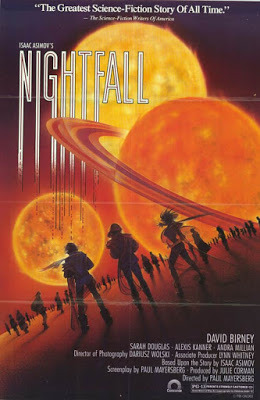Seizing the Day with Asimov’s “Nightfall”
 Like many Americans, I spent yesterday morning trying to figure out how to watch the eclipse without burning my eyes to a crisp. In SoCal we didn’t get to enjoy the whole phenomenon of the sun totally blocked out by the moon’s shadow. But my neighbors and I did enjoy an ad hoc science lesson while lolling on someone’s front lawn. (They had some nifty little glasses they were nice enough to share. I had my pinhole camera made from a cereal box – thanks, Bernie!)
Like many Americans, I spent yesterday morning trying to figure out how to watch the eclipse without burning my eyes to a crisp. In SoCal we didn’t get to enjoy the whole phenomenon of the sun totally blocked out by the moon’s shadow. But my neighbors and I did enjoy an ad hoc science lesson while lolling on someone’s front lawn. (They had some nifty little glasses they were nice enough to share. I had my pinhole camera made from a cereal box – thanks, Bernie!) The whole experience carried me back to 1988, when I was involved with Julie Corman’s production of a famous Isaac Asimov sci-fi story from 1941. Julie, of course, is Roger’s wife, and a producer in her own right. The story, called “Nightfall,” is set on distant planet illuminated by six different suns. Darkness is non-existent; the possibility of a starry sky is discussed by religious cultists but ignored by the rest of society. The narration begins at a moment of crisis for this society: an astronomic quirk has darkened all the suns but one, which is rapidly being blotted out by another celestial body whose presence no one quite understands. The last time something like this happened, society legendarily devolved into chaos, as its citizens began burning everything they owned in a desperate bid for the comforts of light and heat. Asimov, a professor of biochemistry as well as a science fiction writer, is at his most vivid in describing the progression of the eclipse. Early on, referring to the one still-functioning sun, he writes, “Beta was chipped on one side! The tiny bit of encroaching blackness was perhaps the width of a fingernail, but to the staring watchers it magnified itself into the crack of doom.” Soon afterwards, we learn that “Beta was cut in half, the line of division pushing a slight concavity into the still bright portion of the Sun. It was like a gigantic eyelid shutting slantwise over the light of a world.” Finally, as the darkened sky reveals a brilliant star cluster, “thirty thousand mighty suns shone down in a soul searing splendor that was more frighteningly cold in its awful indifference than the bitter wind that shivered across the cold, horribly bleak world.” No wonder the planet’s inhabitants go beserk.
It’s dazzling writing, but Asimov is not especially strong when it comes to action and characterization. The entire story takes place inside a fortress-like lab where scientists try their best to understand (and survive) what’s about to happen. We get several perspectives, but there’s not the sort of rich human drama that the screen demands. We who were working with Julie Corman on writer/director Paul Mayersberg’s screen adaptation all knew that the eclipse would be the film’s climax, but it seemed essential to explore the society that would be turned upside down by the crisis in the heavens. We needed to know these people’s lifestyles and belief systems. And it would be nice to have a love story.
Unfortunately, Mayersberg’s Nightfall gets carried away with its view of an elaborate and somewhat kitsch-driven world, full of exotic rituals and really bad wigs (one worn by the film’s miscast star, TV actor David Birney). And we Cormanites certainly didn’t have the special effects budget to carry off the climax that Asimov’s drama demands. Leonard Maltin pronounced the finished result a BOMB, but Roger Corman—always good at hype—advertised that it was based on “the best science fiction story of all time. And in 2000, Roger sent David Carradine and company to India to try to make Nightfall once again.
Published on August 22, 2017 16:32
No comments have been added yet.
Beverly in Movieland
I write twice weekly, covering topics relating to movies, moviemaking, and growing up Hollywood-adjacent. I believe that movies can change lives, and I'm always happy to hear from readers who'd like t
I write twice weekly, covering topics relating to movies, moviemaking, and growing up Hollywood-adjacent. I believe that movies can change lives, and I'm always happy to hear from readers who'd like to discuss that point.
...more
- Beverly Gray's profile
- 10 followers



